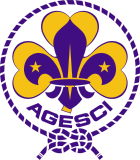Associazione Guide e Scouts Cattolici Italiani
| Associazione Guide e Scouts Cattolici Italiani | |||
|---|---|---|---|
 | |||
| Association of Italian Catholic Guides and Scouts | |||
| Headquarters |
Piazza P. Paoli, 18 00186 Rome | ||
| Country | Italy | ||
| Founded | 1974 | ||
| Membership | 179,761[1] (2015) | ||
| Chief Scout |
Ferri Cormio (Apulia) | ||
| Chief Guide |
Rosanna Birollo (Veneto) | ||
| Presidents of the National Committee | |||
| Ecclesiastical Assistant |
Davide Brasca B. (Lombardy) | ||
|
| |||
|
Website www.agesci.it | |||

   | |||
The Associazione Guide e Scouts Cattolici Italiani (Association of Italian Catholic Guides and Scouts, AGESCI) is a Catholic Scouting and Guiding association in Italy. AGESCI is coeducational and has 179,761 members, including 32,681 leaders (of which 1,862 priests), 1,953 groups and 6,306 units,[1] making it the country's largest Scout association.
AGESCI was formed in 1974 upon the merger of the Associazione Scouts Cattolici Italiani (ASCI, founded in 1916) and the Associazione Guide Italiane (AGI, founded in 1943). Some ASCI and AGI leaders, who had disagreed with the merger (and, above all, opposed the principle of coeducation) and had refused to join AGESCI, formed the Associazione Italiana Guide e Scouts d'Europa Cattolici (AIGSEC or Scouts d'Europa) in 1976, along with disgruntled members of the early AGESCI.
Since 1986, AGESCI has formed, along with the 12,000-strong non-denominational Corpo Nazionale Giovani Esploratori ed Esploratrici Italiani (CNGEI),[2] the Italian Scout Federation (FIS), Italy's national member of the World Organization of the Scout Movement (WOSM) and the World Association of Girl Guides and Girl Scouts (WAGGGS).
Affiliated to AGESCI are the Südtiroler Pfadfinderschaft (SP), the Catholic association of the German-speaking minority in South Tyrol,[3] and the Slovenska Zamejska Skavtska Organizacija (SZSO) serving Slovenes in Friuli-Venezia Giulia.[4]
In 1986 Pope John Paul II was given the Wood Badge insignia as honorary AGESCI leader.
Matteo Renzi, current Prime Minister of Italy, is a former AGESCI leader and editor of an AGESCI newspaper.[5][6]
Organization
AGESCI has a federal structure, composed of regional sections, provincial/diocesan sections and local groups.
The region with more AGESCI members is Veneto (13.4% of the total), followed by Emilia-Romagna (12.7%) and Lombardy (10.3%). As a result, 49.5% of AGESCI members are in Northern Italy (29.6% in Northeast Italy and 19.9% in Northwest Italy), 19.6% in Central Italy and 30.9% in Southern Italy and the Isles. Veneto is first also by groups (11.5%) and units (12.3%).[1]
There are three age ranges/units in AGESCI (and they are present in most groups):
- L/C: Lupetti and/or Coccinelle (Wolf Cubs and/or Brownies), aged 8–11/12, organized into packs.
- E/G: Esploratori and Guide (Explorers and Guides), aged 11/12–16, organized into troops and patrols.
- R/S: Rover and Scolte (Rover Scouts and Ranger Guides), aged 16–21, organized into crews.
Units can be only-male, only-female or coeducational; in the latter case they have to be led by a male leader and a female leader. Mono-sex E/G units are very frequent (43% of the total in Marche, 42% in Liguria, 40% in Emilia-Romagna, 35% in Campania, 34% in Sardinia, 32% in Veneto, 31% Sicily, etc.), L/C mono-sex units are rare and are more likely in regions where the Coccinelle have a strong tradition (25% in Sardinia, 23% in Marche, 17% in Emilia-Romagna, 13% in Campania, 12% in Sicily, etc.), while R/S mono-sex units are even rarer (5% in Sicily and Campania, 4% in Abruzzo, 3% in Calabria, 2% in Apulia and none in the remaining fifteen regions).[1][7]
Each group is co-ordinated by two group leaders and directed by a comunità capi (leaders' community), where all adult leaders and at least a priest belong. It meets quite often (weekly in most cases) to plan all educational activities in the group. Its work is driven by a multi-year (usually three-year) progetto educativo (educational plan), which gives a common thread to the programme of all units, ensuring a common focus across all age ranges. Rover scouts and ranger guides may join the leaders' community upon completing their education and leaving the crew; more specifically, this moment is marked by a ceremony called partenza (departure).
In order to be awarded of the Wood Badge, scout leaders need to go through a lengthy training, mainly consisting of three formation camps.
See also
References
- 1 2 3 4 http://www.agesci.it/download/consiglio_generale/2016/Documenti-preparatori-2016.pdf
- ↑ http://www.cngei.it/chi-siamo.html
- ↑ "Accordo tra Agesci e Südtiroler Pfadfinderschaft". Retrieved 8 January 2007.
- ↑ "Memorandum tra AGESCI e SZSO". Retrieved 8 January 2007.
- ↑ http://www.lanazione.it/politica/2012/09/21/775409-renzi-dall-adolescenza-alla-laurea.shtml
- ↑ http://www.ilfattoquotidiano.it/2013/12/09/matteo-renzi-dai-boy-scout-alla-politica-nazionale-a-colpi-di-rottamazione-e-slogan/805924/
- ↑ http://www.agesci.org/downloads/2013-12-proposta-educativa-03.pdf